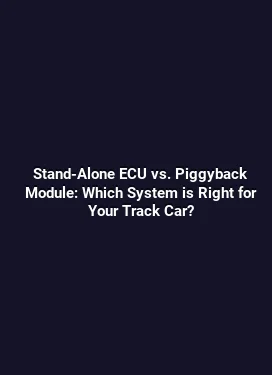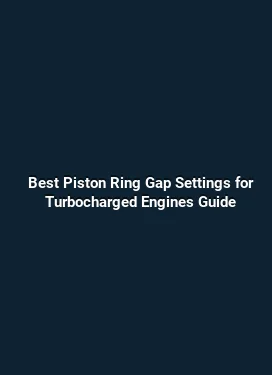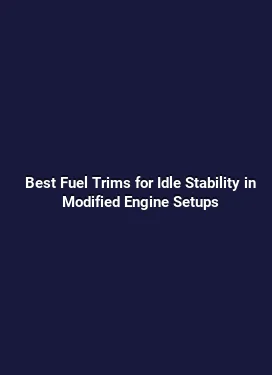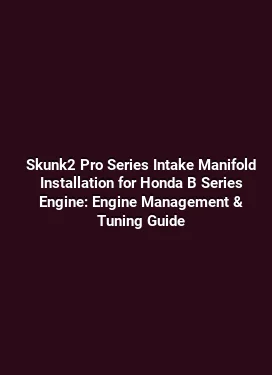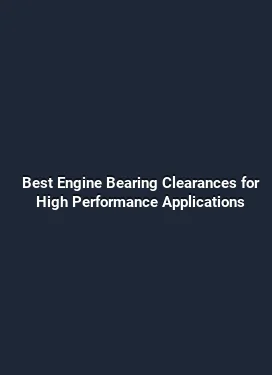Oil Pump Upgrade Guide for High RPM Nissan SR20DET Builds
For enthusiasts pursuing sustained high-rev performance from the Nissan SR20DET, a robust oil supply system is essential. High RPM operation places additional demands on the oil pump and delivery path, influencing bearing life, cam timing, and overall reliability. This guide dives into the engine management and tuning considerations that accompany an oil pump upgrade, offering actionable insights, real-world scenarios, and practical steps to maximize durability and power while maintaining safe lubrication margins under race and track-day conditions.
Understanding Lubrication Demands at High RPM

At elevated engine speeds, the oil pump must deliver sufficient flow and pressure to every rotating component that resides within the crankcase. The SR20DET’s architecture, with its turbocharged nature and variable intake dynamics, can accentuate oil demand during spool-up, sustained high RPM, and aggressive acceleration. The key objective is to maintain a consistent oil pressure curve across RPM and temperature ranges, ensuring that crank bearings, cam followers, valve train components, and turbocharger bearings receive stable lubrication even under sudden load changes.
Several factors influence oil delivery during high RPM operation. Pump gear geometry, clearances within the oil passages, oil viscosity selected for ambient and track temperatures, and the presence of any oil starvation risk due to oil pickup proximity all play a role. When pushing beyond stock limits, engineers often reassess the entire oiling path—from the oil pan to the pickup, through the pump, and up to the galleries that feed the main and rod bearings.
Choosing the Right Oil Pump Upgrade Path
The upgrade strategy for the SR20DET typically revolves around increasing pump capacity, improving oil pickup efficiency, and reducing parasitic losses. The main options include a higher-capacity external pump with an upgraded pickup, a high-volume internal pump, or a combination of both paired with improved oil routing and baffling in the oil pan. Each path has trade-offs in terms of reliability, space constraints, and drive efficiency, so it is important to align the choice with the intended RPM range and track usage.
When evaluating pump options, it is crucial to consider the oil pump’s displacement at your target RPM, the pressure relief characteristics, and the pump’s ability to maintain pressure under high bearing loads. A common approach is to select a pump with a modest increase in flow while ensuring the system’s pressure relief orifices still regulate pressures within safe margins. This helps avoid excessive oil pressure that can lead to bearing surge or cooler oil aeration, both of which can undermine lubrication quality at high speeds.
Integration with the Oiling System

Integrating a pump upgrade requires attention to the oil pickup height, screen filtration, and the pan’s baffling strategy. If the pickup sits too high or too close to the crank, oil surge during cornering or abrupt deceleration can cause momentary starvation. Upgraded pickups often incorporate rigid screen screens and anti-surge features to maintain steady flow through high-G environments. Baffles, flow channels, and windage trays in the oil pan reduce splashing losses and help preserve consistent oil pressure during aggressive driving.
In parallel, revisit the oil cooler loop. Accelerated track sessions generate more heat, and oil cooler effectiveness directly impacts viscosity management. A well-matched cooler that maintains oil at a predictable temperature range supports stable pump performance and reduces thermal thinning of the oil under load. Another practical consideration is choosing an oil with a robust viscosity index that maintains film strength across temperature swings observed in high-RPM operation.
Engine Management & Tuning Considerations for High RPM Flows
Engine management choices influence not only fuel and ignition timing but also how the lubrication system behaves under staggered load profiles. The SR20DET’s digital control strategies can be tuned to accommodate the upgraded pump by coordinating oil pressure behavior with engine speed, load, and thermal states. While the core objective is lubrication reliability, the tuning process must harmonize with fuel delivery, ignition advance, turbo response, and idle stability to avoid unintended transients that could stress the oiling system.
First, establish a baseline map that reflects the stock hardware with the upgraded pump in a controlled, safe temperature range. Monitor oil pressure at various RPMs using a reliable sensor and data logger. The goal is to observe a smooth elevation in oil pressure with RPM, avoiding spikes that could indicate relief valve miscalibration or internal routing restrictions. A gradual pressure ramp also helps the turbo spool more predictably, reducing sudden load changes on the cam and bearing surfaces.
Oil Pressure Targets and Safety Margins
Practical targets vary by build, but a common approach is to aim for a moderate pressure increase at high RPM without exceeding the relief valve’s safe ceiling rating. For example, a well-balanced setup might show 60–80 psi at idle, rising to 70–110 psi at peak power RPM, depending on the engine’s oil temperature and viscosity. The key is monotonic behavior: pressure should rise with RPM and temperature without abrupt fluctuations that could destabilize bearing clearances or cause the oil to aerate under load.
Thermal management is a critical companion to pressure management. As oil temperatures climb, viscosity drops, which can reduce film strength and alter pump efficiency. Ensuring a cooler oil maintains a consistent viscosity helps preserve the intended pressure profile. This interplay between temperature, viscosity, and pressure is especially important during long sessions where oil heats up gradually and then stabilizes, potentially changing the way the pump delivers flow under sustained load.
Fueling, Ignition, and Timing Interplay
In high RPM operations, ignition timing and fueling strategies must stay synchronized with lubrication demands. Excessive ignition advance can cause knock, which in turn elevates engine temperatures and oil shear, demanding more robust lubrication. A tuned map should favor mild to moderate timing advance under boost, with protective knock sensors and fuel trims guiding corrections. Likewise, fuel delivery should ensure stable combustion without excessive rich or lean conditions that provoke heat spikes or detonation risk. Transparent, repeatable data logging capturing air-fuel ratio, ignition timing, boost pressure, oil temperature, and oil pressure provides a clear picture of how all systems interplay under high RPM stress.
Boost management is another lever. Turbos driven at higher RPMs can generate more heat and backpressure, influencing oil demand indirectly. A controlled boost ramp, coupled with a predictable fueling strategy, reduces transients that might escalate engine temperatures. When paired with an upgraded oil pump, this coordination helps maintain steady lubrication during turbo surge and spool events.
Practical Steps for Implementing an Oil Pump Upgrade
Embarking on an upgrade involves a systematic process, from planning to verification. A structured approach minimizes risk and maximizes reliability gains in high-RPM SR20DET builds.
Step 1: Define operating envelope. Determine the target RPM range, track conditions, and maximum sustained heat scenario. This sets expectations for oil pressure, flow, and cooling needs. Step 2: Select compatible components. Choose a pump with proven reliability and install compatible pickups, pan baffles, and cooler hardware designed for higher flow. Step 3: Prepare the oiling path. Inspect and clean all passages. Replace gaskets and seals to prevent leaks under high load. Step 4: Install and verify. Use a high-quality oil with the appropriate viscosity for your climate. Install a calibrated pressure sensor and a data logger to monitor pressures across RPM, throttle, and heat cycles. Step 5: Calibrate the management map. Begin with a conservative baseline, then iteratively adjust to achieve a smooth pressure response without compromising combustion or temperature limits. Step 6: Validate with controlled testing. Perform steady-state and dynamic tests on a dyno or a controlled track session to confirm oil pressure behavior under varied loads and RPMs.
Each step should be documented with data, including oil temperature trends, pressure curves, and torque output. Real-world testing helps identify corner cases—such as extreme lateral G during cornering or rapid deceleration—that might stress the oiling system in ways not evident on a static test bench.
Monitoring, Diagnostics, and Long-Term Reliability
Long-term success hinges on ongoing monitoring and proactive maintenance. A robust data logging setup that records oil pressure, temperature, and flow indicators enables early detection of degradation or anomalies before they become failures. Periodic oil analysis offers insights into bearing wear, contamination levels, and oxidation, which can inform maintenance intervals and oil choice decisions. A practical maintenance routine includes inspecting the oil pickup screen for debris, verifying the integrity of the oil pan and baffling, and confirming that the cooler plumbing remains unblocked and free-flowing.
Additionally, ensure compatibility across all components. Upgrading one piece of the oiling system without addressing the rest can mask symptoms or create new issues. For instance, a higher-flow pump paired with insufficient cooler capacity can lead to higher oil temperatures, negating some of the benefits. A holistic approach that aligns pump capacity, oil cooling, pan baffling, and filter flow ensures the upgrade delivers consistent benefits over time.
Real-World Scenarios: Lessons from Track-Focused SR20DET Builds
In practice, several SR20DET enthusiasts report stable oil pressure and improved reliability after upgrading the pump, particularly when paired with enhanced oil routing and a tuned engine map. In one example, a car running mid- to high-boost levels on track days observed a more predictable oil pressure curve during repeated high-RPM cadence, reducing the likelihood of oil starvation during aggressive cornering. Another case highlighted improved turbo response due to reduced oil pressure fluctuations during boost transitions, translating into more consistent power delivery and reduced heat soak in the valve train during long sessions.
These anecdotes underscore the importance of careful calibration and validation. The upgrade should not be viewed in isolation; it is most effective when integrated into a broader package that includes cooling improvements, filtration upgrades, and a well-rounded tuning strategy. By combining a robust lubrication upgrade with disciplined driving, comprehensive data logging, and methodical testing, SR20DET builds can achieve higher RPM capabilities with durable oiling and reliable performance across a wider range of operating conditions.
Common Pitfalls to Avoid
Avoid selecting a pump too aggressively for a particular chassis without ensuring adequate cooling and pan design. Oversized pumps can raise parasitic losses and tighten tolerances elsewhere. Do not neglect the oil pickup height or pan baffling; even a perfect pump can fail to deliver if the pickup becomes partially blocked or the oil sloshes away from the pickup under hard cornering. Finally, ensure that the engine management strategy accounts for oil-related transients during boost spikes, as abrupt changes can propagate through the lubrication system in unexpected ways.
With careful planning, a well-executed oil pump upgrade becomes a core enabler of high-RPM performance for SR20DET builds. It supports sustained power delivery, robust bearing life, and predictable operation under track-day and competitive conditions, ultimately contributing to a more reliable and responsive driving experience.

